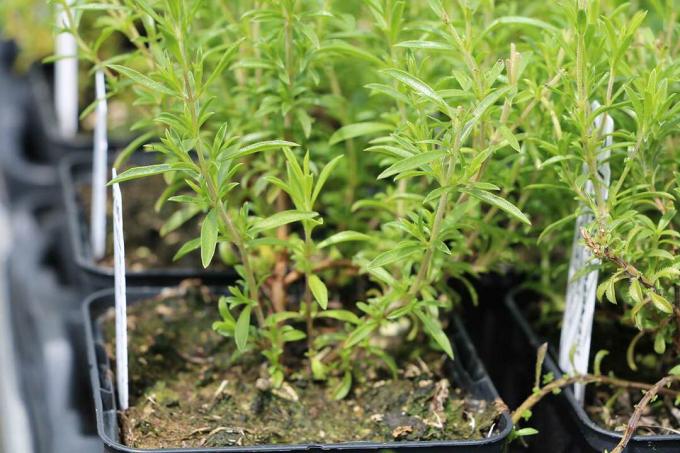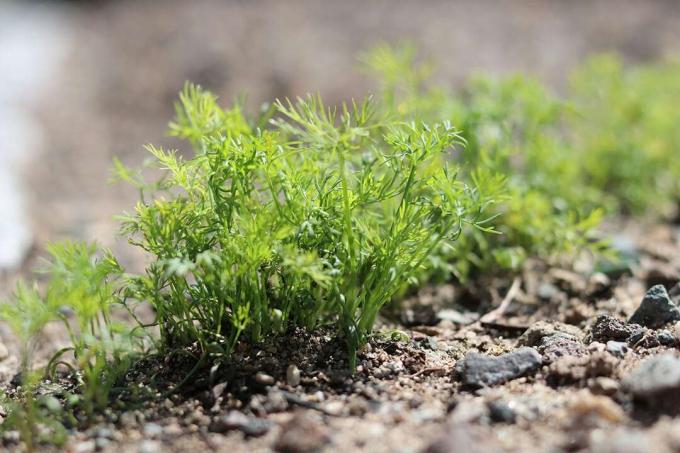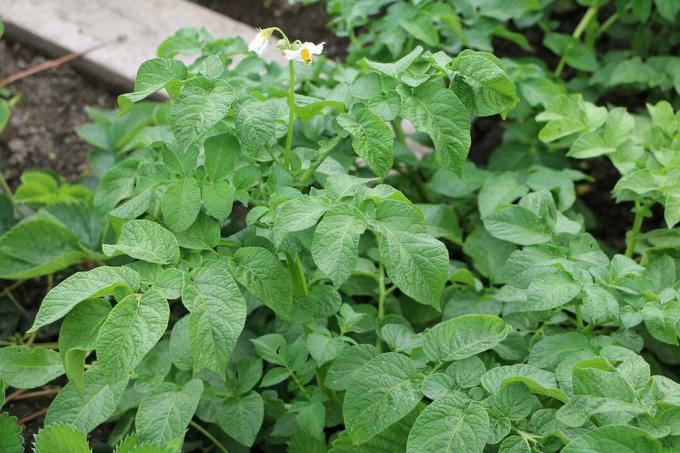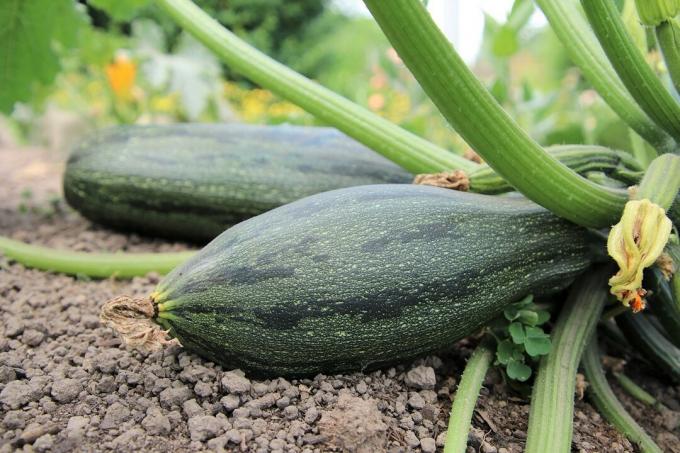
table of contents
- French beans
- Mixed culture
- Good neighbors for French beans from A to J
- from K to Q
- From R to S
- From T to Z
- Bad neighbors for French beans
- frequently asked Questions
Mixed cultures in the vegetable patch not only provide more variety. They have advantages for the respective vegetables in that they keep pests away and reduce disease. This article tells you which neighbors get along well with French beans (Phaseolus vulgaris).
In a nutshell
- Mixed cultures are said to give vegetables advantages
- better growth and aroma
- fewer diseases and pests
- Beans belong to the legumes
- incompatible with himself
French beans
These bean varieties do not grow upright like the climbing runner beans. They form low bushes and therefore need more space in the bed. The row spacing is therefore about 40 cm, within the row the plants should be about 8 cm apart. The French bean prefers a partially shaded location with a medium supply of nutrients.

Mixed culture
Mixed culture is the common culture of different types of vegetables and herbs within a bed or in the immediate vicinity. Please note the following:
- Consider location requirements of all cultures
- Maintain plant and row spacing
- the fertilization depends on the culture with the highest demands
- Prefer direct fertilization on the plant
Note: Flowers or herbs, as neighbors, for the mixed cultivation with French beans are also suitable as border borders.
Good neighbors for French beans from A to J
Savory
This herb grows in sunny and warm locations. There are annual and perennial varieties. The planting distance should be 30 × 30 cm.
- is used to flavor beans
- is also suitable for preserving
- keeps black aphids away from beans

dill
This medicinal and culinary herb is often used with cucumber or fish. It likes sunny to partially shaded locations and is sown either broadly or with a row spacing of 30 cm.
- annual culture
- gives French beans a better flavor
- Forage plant for caterpillars of the swallowtail

Strawberries
This popular type of fruit grows in any nutrient-rich garden soil and doesn't need too much maintenance. The young plants are then planted out at a distance of 25 cm in the row and 30 cm between the rows.
- perennial culture
- is suitable for many mixed cultures
- benefits from the nitrogen-producing bacteria of the French bean

Cucumber
Cucumbers can be eaten immediately after harvest or processed in salads, for example. They thrive best in warm, humid, sunny, but sheltered locations. As heavy consumers, they also need nutrient-rich soil.
- annual
- Distance between plants: 100 x 40 cm
- uses nitrogen from French beans

from K to Q
potatoes
Potato cultivation prepares unused garden soil very well for the following crops. If new potatoes are used, other vegetables can follow in the same year.
- annual culture
- Heavy eater, uses nitrogen from beans
- takes up a lot of space
- accumulation necessary, take into account with mixed culture
- Beans keep Colorado beetles away

celery root
Celeriac is the cultivated form of celery that is most widely grown in Germany. The vegetables should be planted in a sunny to partially shaded location.
- Heavy Eater
- moist, loose soil
- Plant spacing: 40 x 30 cm

Types of cabbage
Cabbage is particularly versatile. While rose and cauliflower, just like broccoli, are good for freezing, red cabbage is also tasty when made into red cabbage and cooked down.
- annual crops
- mostly heavy consumers
- French beans well suited as underplanting for tall types of cabbage (rose or kale)

Kohlrabi
Kohlrabi is a straightforward, fast-growing cabbage vegetable. With strategic sowing it can Kohlrabi harvested several times will. A sunny to partially shaded location and humus-rich, evenly moist soil are ideal here.
- basically every two years
- Central Eater
- Plant spacing: depending on the variety between 25 x 30 cm and 40 x 50 cm
- because of the small footprint, welcome stopgaps in crop rotations

Swiss chard
Swiss chard is mainly grown in Italy and the Balkans, but leafy vegetables are also becoming increasingly popular in this country. No wonder, as the cultivation is quite undemanding.
- sunny to partially shaded location
- evenly moist, nutrient-rich soil
- Central Eater
- tolerates light to medium frosts
- Plant spacing: 40 cm, 23 cm in staggered rows in raised or deep beds

From R to S
radish
Radishes are ideal neighbors for French beans mainly because of their short cultivation time of three to four weeks and their small footprint.
- annual
- sunny, airy location
- Weak eaters
- Plant spacing: 5 to 7 cm

rhubarb
Rhubarb is only edible when cooked. The leaf stalks taste very good as a compote or with Strawberries on cake. The plants need a lot of space and should therefore be divided after a few years.
- perennial culture
- Heavy Eater
- benefits from nitrogen in the soil
- provides shade for the beans

Beetroot
Beetroot is not only easy to cultivate, but also very storable. So it can be used as a cooked vegetable garnish, salad, soup, smoothie or coloring agent.
- biennial
- full sun, warm to partial shade
- Central Eater
- Row spacing: 25 cm

Salads
Salads always go - they taste best fresh from the garden. When grown, the vegetables do not have high soil requirements. Only acidic and muddy soils should be avoided.
- different types: lettuce, chicory, radicchio, endive ...
- sunny to shady location depending on the variety
- regular watering necessary

spinach
The short cultivation time of the spinach makes it the ideal partner for French beans. Roots left in the ground after harvest also provide a good substrate for the beans.
- annual
- humus-rich, well-drained soil
- full sun to partially shaded location
- Plant spacing: 20 - 25 cm

Celeriac
In contrast to celeriac, celeriac only forms a small tuber, but it has pronounced stems. It needs a sunny to partially shaded location for ideal growth.
- perennial
- Heavy Eater
- frost tolerant; can be harvested directly from the bed in mild winters
- Plant spacing: 50 x 50 cm

From T to Z
tomato
Tomatoes are one of the most popular vegetables to grow on your own. You need nutrient-rich soil and a sunny, warm and sheltered location.
- annual
- Heavy Eater
- use nitrogen from French beans
- Be careful that tall crops don't shade beans too much

zucchini
Whether steamed, grilled or fried, zucchini are becoming increasingly popular. Just like tomatoes, they need nutrient-rich soil and a sunny, warm and sheltered location.
- annual
- Plant spacing: 1 to 2 meters
- use nitrogen from French beans

Note: Basically, beans like the neighborhood of fruit vegetables, but paprika is an exception. Paprika is better off in the greenhouse anyway.
Sweet corn
Corn grows up to 2 meters high and is therefore more suitable for the edge of the vegetable garden. There is then a lot of space around the maize for underplanting.
- annual culture
- Heavy Eater
- Beans provide nitrogen for the corn

Bad neighbors for French beans
peas
- annual culture
- Central Eater
- belongs to the same plant family
- therefore mutual promotion of pests and diseases is possible
fennel
- annual culture
- Central Eater
- Umbelliferous plants
Onion vegetables (e.g. B. Garlic, leek, onions)
- annual crops
- mostly weak consumers
- do not tolerate too much nitrogen

frequently asked Questions
The more vegetables you want to grow together in one bed, the more difficult it will be to find the right neighbors. Therefore, it makes more sense to limit yourself to a few varieties that get along well with each other.
In mixed culture, different plants are planted together if they protect each other and support each other in growth. With crop rotation, it is avoided to plant the same plants or plant families in the same location several times in a row. There is a break of several years.
This is not advisable, as both pests and diseases can occur more frequently. However, if it is a small garden and if the crop rotation cannot otherwise be adhered to, it is the better alternative.



